Experiment on changing my MTB handle bar with BMX! Its improve the comfort!
Recent newsUnbelievable! Its comfort actually!
read more(Comments)
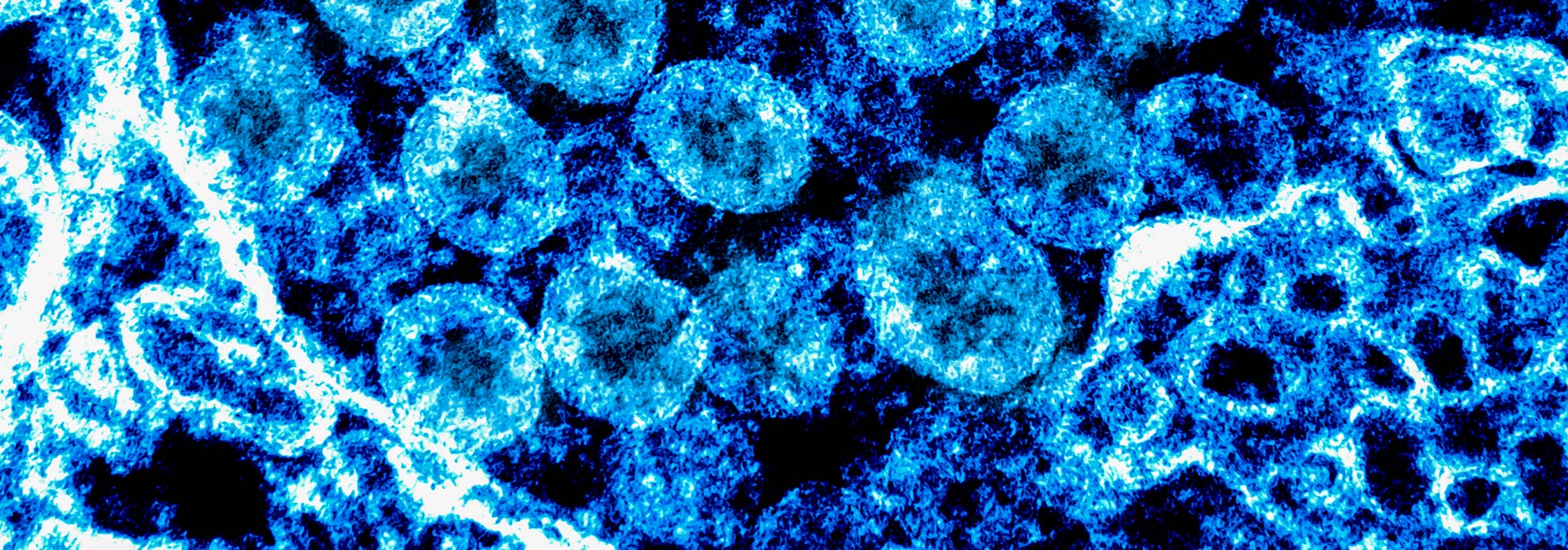
SARS-CoV-2 virus
Transmission electron micrograph of SARS-CoV-2 virus particles.
Image: NIAID

Panorama view of Wuhan, the capital of Hubei province. On the left bank of the Yangtze river is Wuhan's Tortoise Mountain TV Tower (Hanyang), Wuhan Center (Hankou). The Wuhan Yangtze Great Bridge connects Turtle Hill in Hanyang with Snake Hill in Wuchang. Wuhan Greenland Center (under construction in 2017) and Yellow Crane Tower (far right, in Wuchang). Three towns merged to form modern-day Wuhan: Hankou, Hanyang, and Wuchang.
Image: 射手座
Life postponed. No more hugs, no more high fives, no more whispers in your ear.
Remember The Police song: Don't Stand So Close To Me.It is just three months since a violent virus is running rampant. It only took 90 days for the SARS CoV-2 virus to conquer the whole world.
To stop the virus, it is crucial not to get infected. But how? Keep your distance. Literally everybody could be a germ carrier. To avoid transfer, protect yourself. Keep your distance. The virus is present in the air that your counterpart exhales or on surfaces that you touch.
Protect your mouth and nose with a respirator mask, or a scarf, or look the other way. The virus enters your body through your airways and also through your hands when you touch your face. Get aware of how often you touch your face. Wash your hands. Soap and high-proof alcohol will neutralize the virus. Get ahead of the virus now. By protecting yourself, you protect your family and friends.
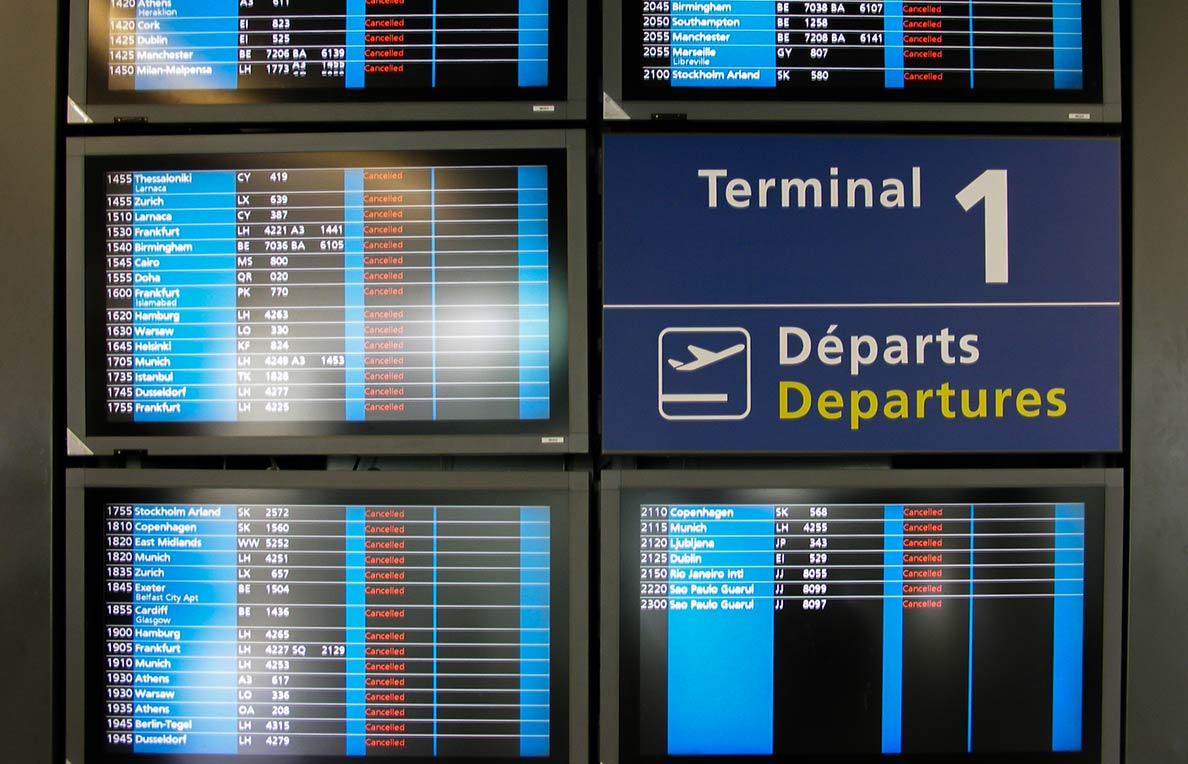
International air traffic canceled.
Image: Mathieu Marquer
The world shuts down as COVID-19 spreads. Closed attractions and landmarks, whole cities under quarantine, and entire countries on lockdown.
Federal authorities around the world currently discourage all non-essential travel, and many countries have closed their borders. (see also: Global Travel Warnings)
Supply chains are severely disrupted. International air traffic is canceled. Airlines operated empty "ghost" flights, just to keep their slots. Stock markets are on a rollercoaster ride.
There are no more shows, cinemas, or sports events. Factories and schools are closed. Millions of people are under quarantine, and millions of jobs are at risk.
Is there a way out? Possibly, the infection rate in China and South Korea, two countries with the most cases, seems to have slowed down. It may be too early to see it as the end of the epidemic, but it is a beginning, perhaps.
COVID-19
The world is facing the most serious public health crisis in generations.
Prof. Neil Ferguson
Director, J-IDEA
At the end of last year, an unknown pathogen went viral. It spread from its origin to a handful of first victims in a highly urbanized environment. Unhindered, the extremely contagious virus infected hundreds and then thousands of human beings and used them as carriers.
Viruses are not able to replicate themselves; they are entirely dependent on a host cell to survive and reproduce. The pathogen had chosen the right place to linger, the most populous country on earth. Riding its human host, the virus was ready for takeoff, literally.
Within eight weeks, the pathogen arrived on all continents. It pops up in one country, then another, and then it mushrooms. Within three month the virus has now spread to almost all countries/territories.
The disease can spread from person to person through small droplets. Symptoms are similar to the common flu: fever, dry cough, shortness of breath, and tiredness - it's not a running nose. These symptoms are usually mild. Older persons and people with pre-existing medical conditions appear to develop a serious illness more often than others.
World Map of COVID-19 Outbreak
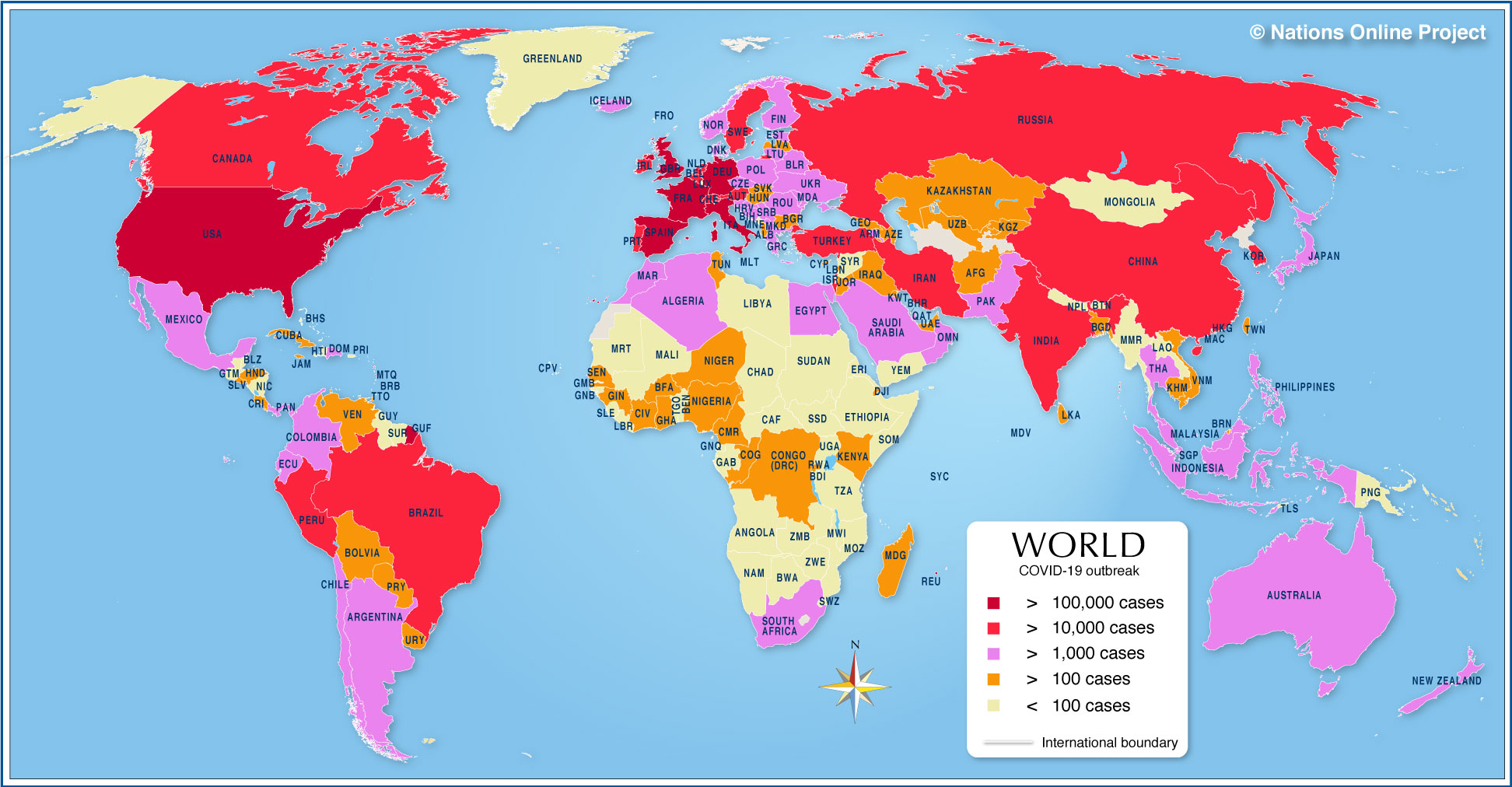
World Map shows spreading of SARS-CoV-2 Coronavirus (COVID-19) by countries around the world.
Global Coronavirus Cases. The updated world map of SARS-CoV-2 coronavirus outbreak shows countries with number of confirmed COVID-19 cases (as of 17 April 2020). The actual number of cases is shown below.
(list of three-letter country codes)
You are free to use the above map for educational purposes (fair use); please refer to the Nations Online Project.
The map illustrates the spread of the coronavirus worldwide. The map shows countries where cases of the new coronavirus have been confirmed.
Confirmed COVID-19 (2019-nCoV or SARS-CoV-2) Cases
In February, the World Health Organization announced the official name for the disease caused by the new coronavirus is COVID-19, the virus is named Severe Acute Respiratory Syndrome CoronaVirus 2 (SARS-CoV-2).
The numbers are frightening, but it might get much, much worse. Only 0.01% of the world's population is affected by COVID-19 today. It only took three months for the virus to conquer the whole world.
The virus has now spread to 185 countries/territories.
Unfortunately, the number of countries with confirmed cases is still growing daily, although China now reports fewer new cases.
Global total confirmed COVID-19 cases 2,150,000+ about about 100,000 more cases per day.
(The number of cases by country in brackets)
More than 100,000 cases
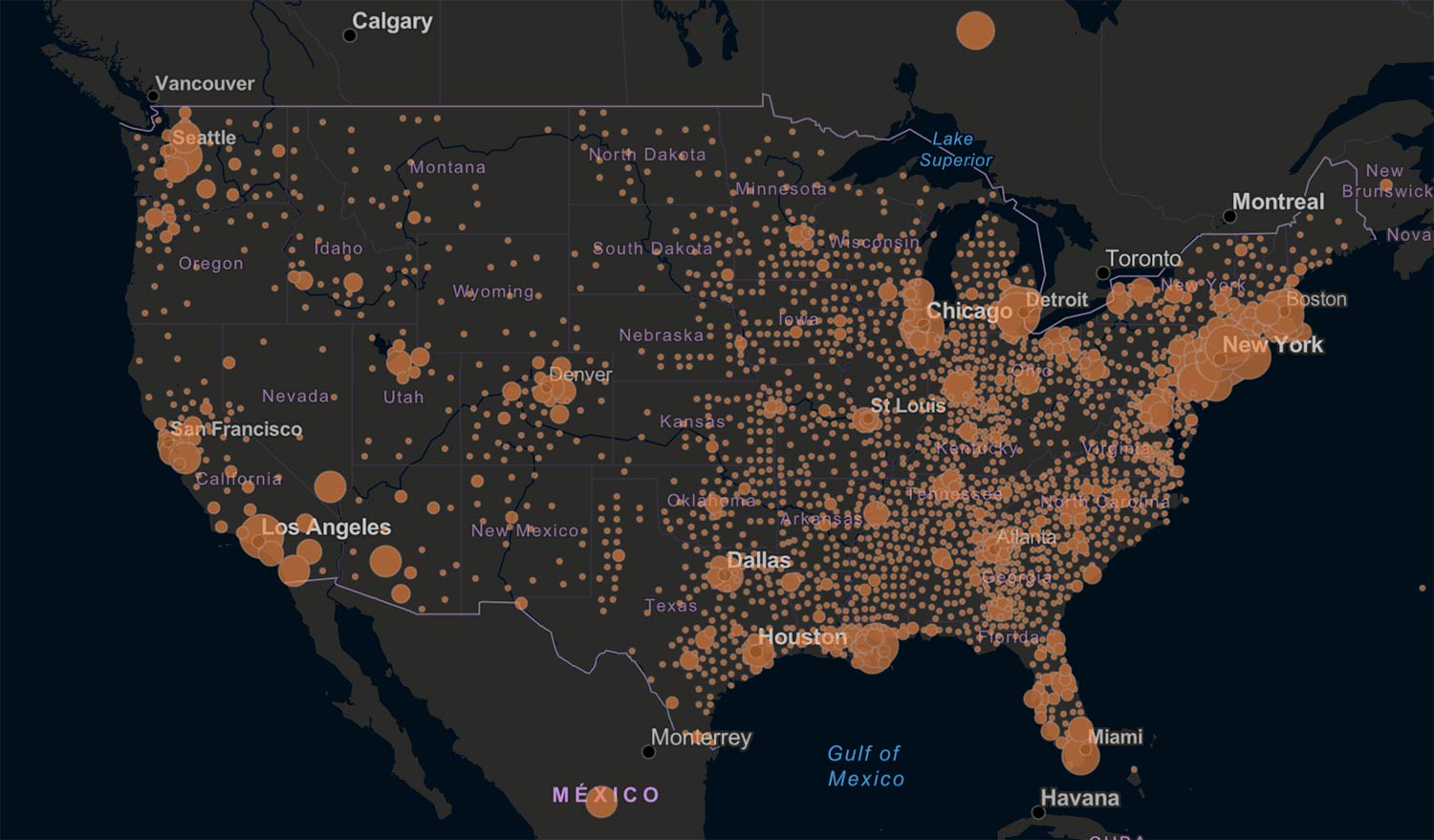
Map of active COVID-19 cases in US mainland.
Image: Johns Hopkins University
USA (671,000+; in New York State alone: 223,000+)
Spain (185,000+)
Italy (169,000+)
France (147,000+)
Germany (137,200+)
United Kingdom (104,100+)
More than 10,000 cases
China (82,800+; in Hubei province alone: 67,800)
Iran (78,000+)
New Jersey US (75,300+)
Turkey (74,100+)
Belgium (34,800+)
Massachusetts US (32,180+)
Canada (30,900+)
Brazil (30,600+)
Netherlands (29,400+)
Michigan US (29,200+)
Pennsylvania US (28,300+)
California US (28,000+)
Russia (28,000+)
Switzerland (26,700+)
Illinois US (25,700+)
Florida US (23,300+)
Louisiana US (22,500+)
Portugal (18,800+)
Texas US (17,200+)
Georgia US (16,360+)
Connecticut US (15,800+)
Austria (14,400+)
India (13,400+)
Ireland (13,200+)
Israel (12,700+)
Sweden (12,500+)
Peru (12,500+)
Washington US (11,200+)
Maryland US (10,700+)
South Korea (10,600+)
More than 1,000 cases
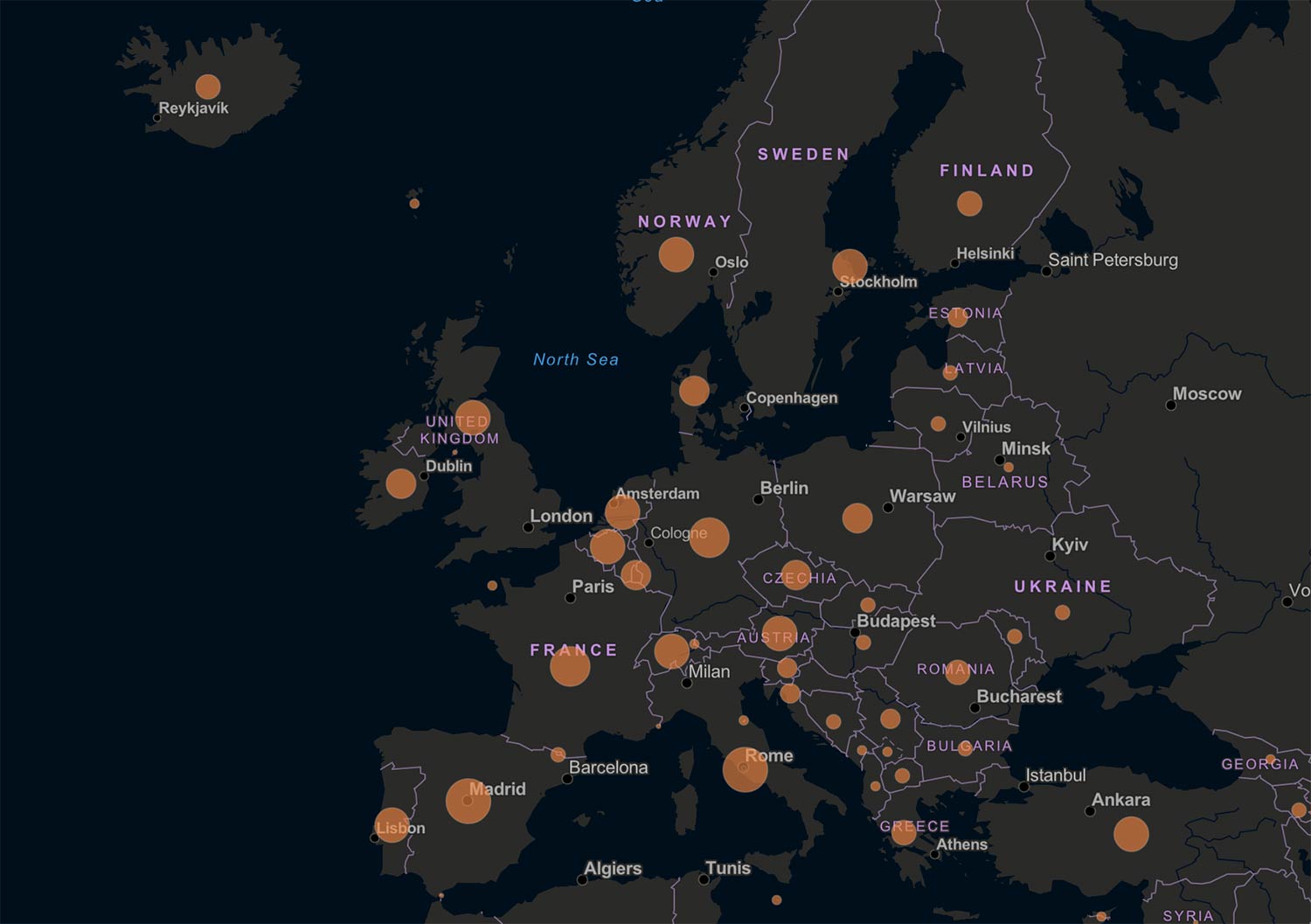
Map of active COVID-19 cases in Europe.
Image: Johns Hopkins University
Japan (9,200+), Chile (8,800+), Ecuador (8,200+), Poland (7,900+), Romania (7,700+), Denmark (7,000+), Pakistan (6,900+), Norway (6,900+), Australia (6,400+), Czechia (6,400+), Saudi Arabia (6,300+), Mexico (6,300+), United Arab Emirates (5,800+), Philippines (5,600), Indonesia (5,500+), Serbia (5,300+), Malaysia (5,200+), Singapore (4,400+), Belarus (4,200+), Ukraine (4,100+), Qatar (4,100+), Panama (4,000),
Dominican Republic (3,700+), Luxembourg (3,400+), Finland (3,300+), Colombia (3,200+)
Egypt (2,600+), Thailand (2,600+), Argentina (2,600+), South Africa (2,600+), Morocco (2,200+), Algeria (2,200+), Greece (2,200+), Moldova (2,100+),
Croatia (1,800+), Iceland (1,700+), Bahrain (1,700+), Hungary (1,600+), Bangladesh (1,500), Kuwait (1,500+), Estonia (1,400+), New Zealand (1,400+), Iraq (1,400+), Kazakhstan (1,400+), Uzbekistan (1,300+), Azerbaijan (1,300+), Slovenia (1,200+), North Macedonia (1,100+), Lithuania (1,100+), Armenia (1,100+), Bosnia and Herzegovina (1,100+), Oman (1,000+), Hong Kong SAR (1,000+),
Less than 1000 cases
Cameroon (996), Slovakia (977), Cuba (862), Afghanistan (840), Tunisia (822), Bulgaria (800), Cyprus (735), Andorra (682), Latvia (675), Lebanon (663), Cote d'Ivoire (654), Costa Rica (642), Ghana (641), Niger (609),
Djibouti (591), Burkina Faso (546), Albania (518), Uruguay (502)
Kyrgyzstan (466), Bolivia (465), Kosovo (449), Nigeria (442), Guinea (438), Honduras (426), San Marino (426), Malta (412), Jordan (400),
Taiwan (395), Palestine (374), Georgia (348), Senegal (335), Mauritius (324), Montenegro (303),
Vietnam (268), DR Congo (267), Sri Lanka (238), Kenya (234), Guatemala (214), Venezuela (204),
Paraguay (199), Faroe Islands (184), Mali (171), El Salvador (164), Jamaica (143), Rwanda (138), Brunei (136), Cambodia (122), Congo Rep. (117), Trinidad and Tobago (114), Madagascar (111)
Less than 100 cases
Martinique, Guadeloupe, Liechtenstein, Macau, Monaco, French Guiana, Togo, Barbados, Zambia, Uganda, Maldives, Tanzania, Ethiopia, Equatorial Guinea, Dominica, Mongolia, Gambia, Guam, Seychelles, Nepal, Gibraltar, Bhutan, Vatican City, Saint Barthelemy, Puerto Rico, Namibia, Aruba, Central African Republic, Gabon, Saint Vincent and the Grenadines, French Polynesia, Antigua and Barbuda, Sudan, Saint Lucia, Swaziland, Suriname, Mauritania, Liberia, Greenland, Somalia, Benin, The Bahamas, Guyana, Libya,
Belize, Botswana, Cape Verde, Eritrea, East Timor, Zimbabwe, Papua New Guinea, Chad, Angola, Haiti, Fiji, Nicaragua, Syria, Mozambique, Guinea-Bissau, Laos, Burundi, Sierra Leone, Malawi, Yemen, Myanmar (Burma), South Sudan.
As of today, about 543,000+ people have recovered from the disease and may now be immune to the virus.
More than 144,000+ people have succumbed to the disease.
Sources: US CDC, ECDC, Johns Hopkins University, NHC China, RKI, Australia DOH, MDS Spain, SP France, gov.uk, canada.ca, politi (DK), MDS Italy, FOPH Swiss, and other reliable sources.
Note: Some of the figures should be regarded with caution. The various countries have different motives for making their statistics look good. It is not only about the published statistics, but also about the absence of information. In particular, with regard to China's activities in countries in Asia, Africa, and Latin America. Chinese citizens live and work in these regions, and they had visited their families at home during the Lunar New Year celebrations.
It is suspected that the number of cases in overpopulated India is much higher than reported, also due to lack of testing.
It is suspected that the number of cases in Iran is much higher than reported.
It is suspected that the number of cases in Russia is much higher than reported.
It is also suspected that the number of cases in the United States is much higher because, for various reasons, the authorities have not tested the American people for the virus.
COVID-19 Outbreak
The world watches dumbfounded a scenario normally only known from B movies. A worldwide pandemic was looming on the horizon, and the center of the outbreak was the most populated country in the world -- a country that is not exactly known for its transparency and its respect for human rights.
In the beginning, the outbreak of a new virus was ignored and denied by Chinese officials. People who warned of the disease were called in by both medical officials and the police.
The outbreak happened at an unfortunate time, the Spring Festival. During the festival, millions of people are going to visit their families; they travel all over the country and abroad. The event is known as the world's most massive annual human migration, and it was an excellent opportunity for the virus to spread.
Drastic measures on a gigantic scale were taken. Overnight megacities came under lockdown. Public transport was suspended; trains, buses, subways, and ferries were no longer in operation.
When the outbreak could no longer be ignored or stopped, drastic measures on a gigantic scale were taken. Overnight megacities came under lockdown. Public transport was suspended; buses, subways, and ferries were no longer in operation; motor vehicles were banned in central urban areas; airports and railway stations were closed to outgoing passengers. But when the lockdown policies kicked in, half of Hubei's population has already left for the holidays.
The residents in cities affected by the virus started to hoard supplies and isolated themselves at home. Medical masks suddenly became part of the human face, and megacities became ghost towns with deserted streets. And China had all of a sudden a real climate change, a blue sky.
To treat the many virus patients, the country built the Huoshenshan Emergency Hospital in Wuhan, with a capacity of 1,000 beds, in just ten days. Shortly afterward, more hospitals had mushroomed.
Meanwhile, some neighboring countries have banned the entry of all Chinese visitors. Now, more and more nations worldwide have introduced some form of immigration control for Chinese citizens or for anyone who has recently traveled through regions affected by the disease.
In China, the number of cases of infection is still increasing, and measurements against the virus have become more and more desperate. Temperature screening for everyone has become routine. Millions of residents are ordered to report their body temperature to health officials every day. Empty streets of entire city blocks were sprayed with disinfectants. Banks were instructed to disinfect yuan bills, then seal them and store them for seven to 14 days.
The virus outbreak brought "the world's factory" to a grinding halt. China is a significant supplier to many industries in the West, but a large number of China's factories remain closed, and the supply chain is severely disrupted. It is only now that consumers in the West become aware that their favorite products are wholly or partly made in China.
Infection Rate
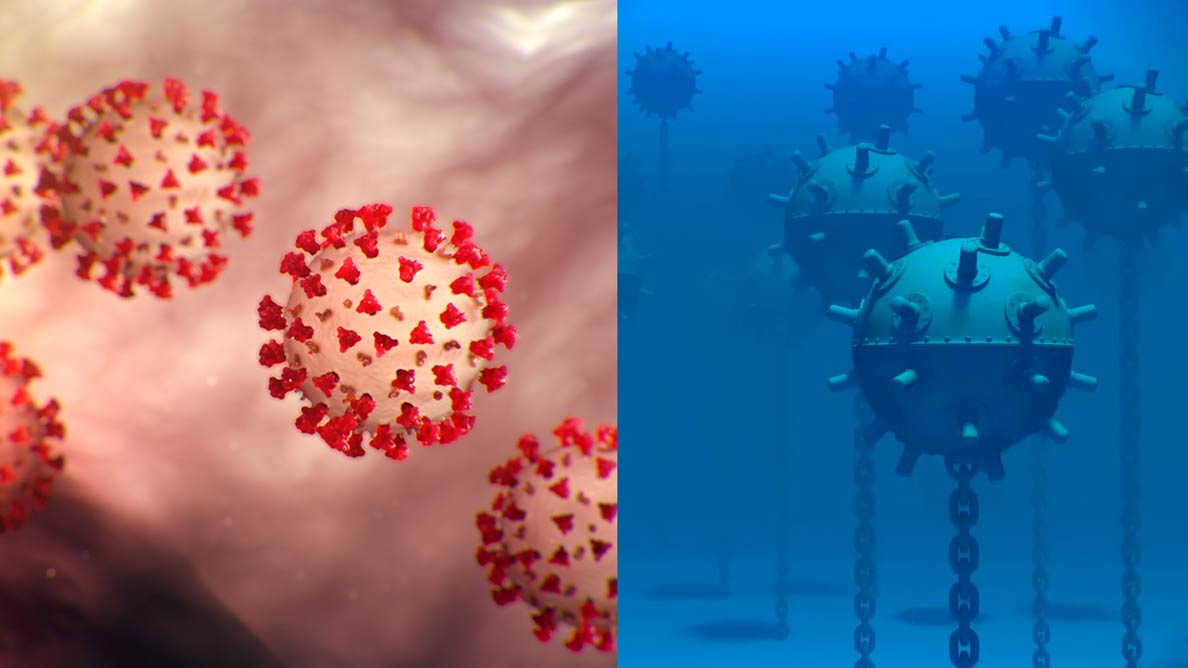
The invisible danger. But it seems that the new coronavirus is scarier and more fatal than old fashioned sea mines.
The rate of infections within China and South Korea appears to have slowed, but several other countries are experiencing a sharp increase in confirmed COVID-19 cases. Among them is Italy, where the number of cases had increased from three to more than 4,600 people infected with the virus. Italy became the country with the most cases in Europe, and days later, the country with the most cases outside China with more than 12,000 cases.
The number of cases in South Korea has quadrupled in just some days. South Korea's dramatic rise of COVID-19 infections (7,800) stems from the city of Daegu, where a religious group with more than 240,000 followers known as Shincheonji has been blamed for preventing the government from containing the epidemic by failing to provide a full list of its members.
A similar picture in Iran, the country experienced a flood of COVID-19 cases to now more than 10,000+.
Zombies
If this is kind of a B movie scenario, where are the Zombies? Rest assured, they are here. They hide in the so-called Social Media. The same sort of braindead dimwits who vandalized guestbooks and forums in the early internet now lurk on Facebook, TikTok, Twitter, and co. They spread rumors, fabricated stories, and outright false information, just for the fun of it.
Racist memes and slurs have increased to such an extent that the World Health Organization already calls it an "infodemic." [1] Even tabloids such as the New York Post are striving for higher sales with a story that is difficult to verify with the headline: "Don't buy China's story: The coronavirus may have leaked from a lab."
A special kind of zombies you will find in supermarkets, where they fight for toilet-paper and pasta.
The greates Zombie is probably Donald Trump. According to Germany's prestigious news show Die Tageschau, the US President was apparently trying to lure German scientists to America with large financial contributions to secure the Coronavirus vaccine exclusively for his country. So much for his: "We are all in this together." That was lie number 16,666 (estimated).
Maybe even more pestilent Zombies sit in Russia. According to an internal EU report, Russian pro-Kremlin media have launched a "major disinformation campaign". The campaign aims to destroy confidence in the emergency response of western countries in their handling of the coronavirus crisis. [FT]
Don't Panic
In the face of a pandemic, don't panic. Take a deep breath, good. Now count to a trillion, great. Now you can panic.
Preparedness
The world is not prepared for a pandemic. Rich countries preferred to spend their money on other things than real emergency management; poor countries simply do not have the means. Politicians, some "experts," and a variety of media outlets will tell you the opposite. Well, get well soon.
Hoarding
Due to the worldwide outbreak of the coronavirus, people start to think about what they would need if they had to stay home for a couple of weeks.
From Melbourne to San Diego to Berlin, the most popular items for hoarding are similar worldwide, water, canned and frozen food, pasta, disinfectants, and - toilet paper. Panic buying of protective masks and other personal protective equipment were also observed.
Treatment
Your best weapon against the virus is your immune system and the amazing self-healing capability of your body. Until now, there is no vaccine against the virus. Institutions around the world are conducting research, but results are not expected for several months.
You have to be proactive to avoid catching the virus. By now, you know the drill: wash your hands, keep your hands off your face, keep social distance, if you feel ill, stay at home.
(to be continued)
What's happened so far.
In December 2019, an accumulation of severe pneumonia of unknown cause was observed in Wuhan, a Chinese megacity on the Yangtze River. The first known human infection of the new virus occurred eventually in early December 2019, but some experts suspect that the infections occurred weeks earlier, even already in October 2019.
What makes the novel virus so dangerous?
The fact that the virus previously was unknown to medical science and the transmission from human to human is possible. If the virus can gain a foothold in the population depends on whether there are asymptomatic or mild infections in which those affected do not see a doctor. The symptoms of the disease are fever, dry cough, muscle pain, and exhaustion. Within one week, the patient's condition may deteriorate significantly with respiratory distress, which requires immediate admission to a clinic.
Outbreak

Chinese New Year decoration for the Spring Festival 2020, the year of the White Metal Rat.
Image: kk nationsonline.org
It was the most unfortunate time for a disease outbreak, the beginning of the Chinese New Year (Spring Festival) festivities, the most important holiday on the Chinese calendar. During the festival, millions of Chinese are going to visit their families all over the country and abroad. This event is known as the world's most massive annual human migration.
By the end of the Spring Festival, millions of Chinese people are on the move again, if the local authorities allow it. The government of Hubei has announced that it will extend the one-week spring festival holiday until 13 February to delay the return.
The rapid spread of the virus prompted Chinese authorities to take unprecedented measures. China has sealed off several large cities with an estimated population between 40 and 50 million people to contain the coronavirus. The country enacted travel bans, public transport was closed down, and flights canceled. Fear was growing among the population; people turn to self-help and block districts and villages to deny access to strangers, the BBC reported.
Spreading
The virus spread rapidly within the city of Wuhan and in Hubei province and from there to all regions of China, but on a much smaller scale. From China, the virus was carried to other parts of the world (see the map below). China's Hubei province is at the center of the outbreak; it is the province with the by far most cases of the illness, with more than 25,000 people down with the coronavirus. (Source: WHO)
Compared, China is about the size of the United States, but its population is more than three times bigger.
Now, there are several cases in South America (Brazil, Argentina, Chile), and in Africa, the virus started to gain a foothold (Egypt, Algeria, Morocco, Nigeria, and now Senegal and Togo).
Africa
Now, Africa has its first confirmed cases of coronavirus after a person in Egypt tested positive for the disease. Some days later, Algeria confirms the second case of coronavirus in Africa. [12] [13]
In this context, SARS had a mortality rate of about 10%, the fatality rate of the COVID-19 disease is at approximately 3%, making it three times more lethal than the seasonal flu, which has a mortality rate below 1% typically.
The 1918 influenza pandemic caused by an H1N1 virus killed 50 million people worldwide, with a mortality rate of about 10%. [14]
More about the Coronavirus
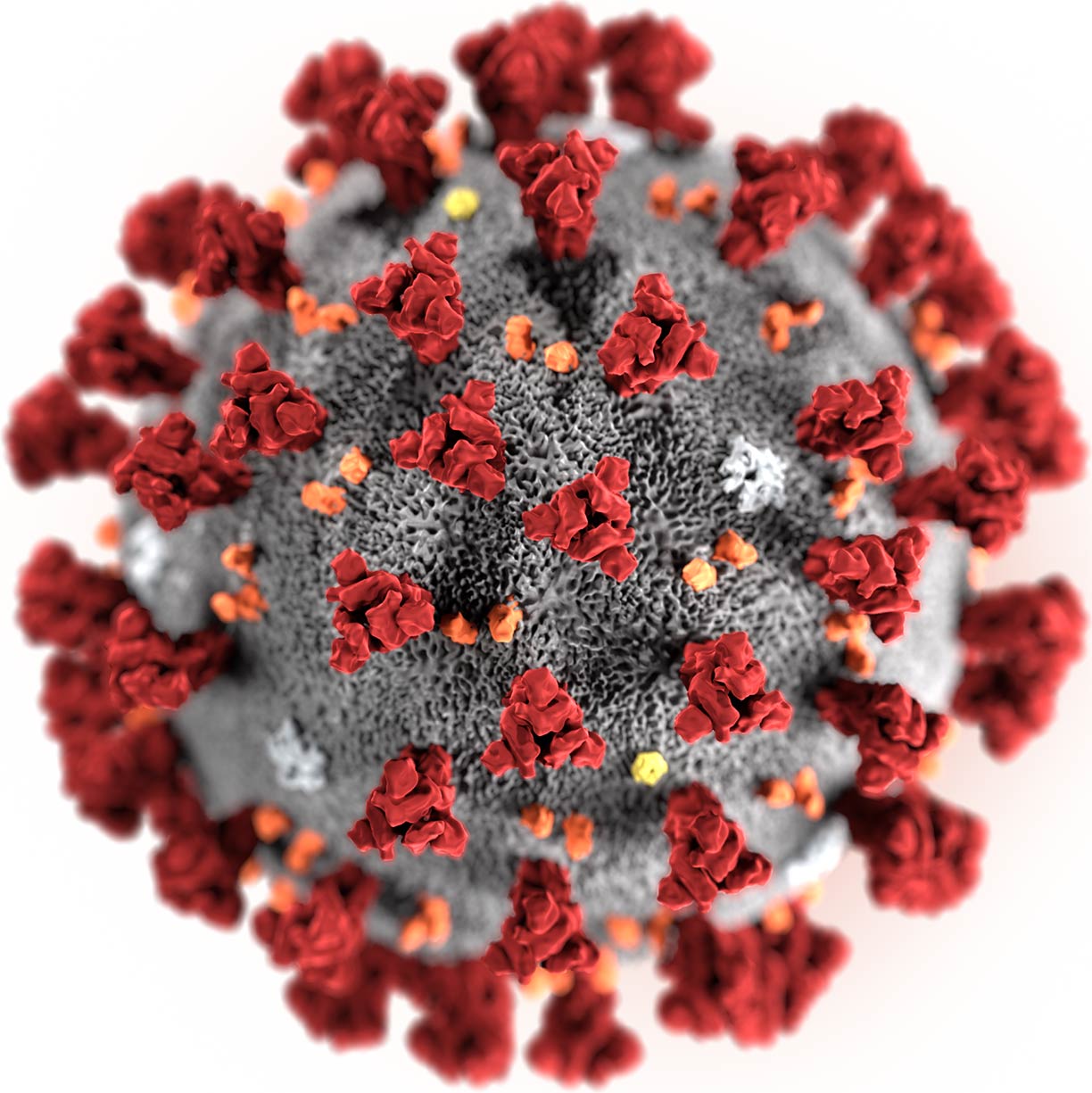
This image reveals ultrastructural morphology exhibited by the 2019 Novel Coronavirus (now known as SARS-CoV-2). The image was rendered at the Centers for Disease Control and Prevention (CDC).
Image: CDC Organization, Alissa Eckert, MS, Dan Higgins, MAM
The vast majority of scientists believe that viruses are not living organisms. A virus does not have a metabolism; it cannot reproduce without a foreign host cell.
Viruses are the cause of diseases like AIDS/HIV, Ebola, hepatitis C, herpes, influenza, measles, mumps, glandular fever, rubella, and rabies.
The infective parasitic agent is small, too small to be seen with an optical microscope, about one hundredth the size of most bacteria.
Viruses can infect humans, animals, and plants. Antibiotics are ineffective against viruses!
Vaccination
There is currently no vaccine that could prevent infection with the SARS-CoV-2 virus or cure people of the disease.
Work on the development of a vaccine for this new coronavirus strain has begun at various organizations, including the National Institutes of Health (NIH). Still, the development of a vaccine against the novel coronavirus will probably take months.
How long until recovery
Recovery depends on the strength of the immune system. Those affected with a mild form of the disease usually recovered within two weeks. For people with a severe course of the disease, it takes between three and six weeks of the illness to subside.
Those affected are likely to be contagious throughout the entire period of the illness.
The World Health Organization, which has been criticized for its handling of past disease outbreaks, said the global risk from the deadly coronavirus is "high" after cautiously classifying the global risk as "moderate" before.
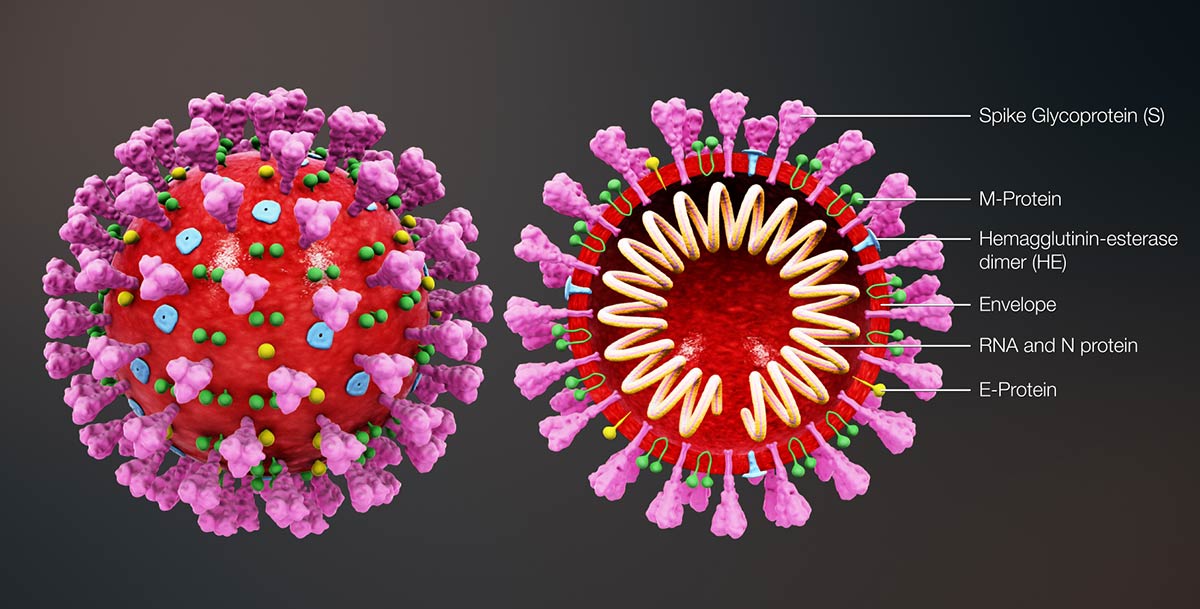
3D illustration of 2019 Novel Coronavirus (now named SARS-CoV-2), derived from a CDC released image.
Image: Scientific Animations Inc., CDC Organization
China: Very High
Regional Level: Very High
Global Level: Very High
Countries with infected patients appear not to be able to contain the spread of the virus.
The spread of the virus outside China has accelerated, and a spreading of the disease could not be prevented.
How many people die from the flu each year?
By comparison, 14 - 20 million people (4 - 6% of the total population) fall seriously ill with influenza in the US every year, between 34,000 and 60,000 cases are fatal (0.1%), even though there is a vaccine against the flu. [15]
Graphical representation of the worldwide confirmed COVID-19 cases
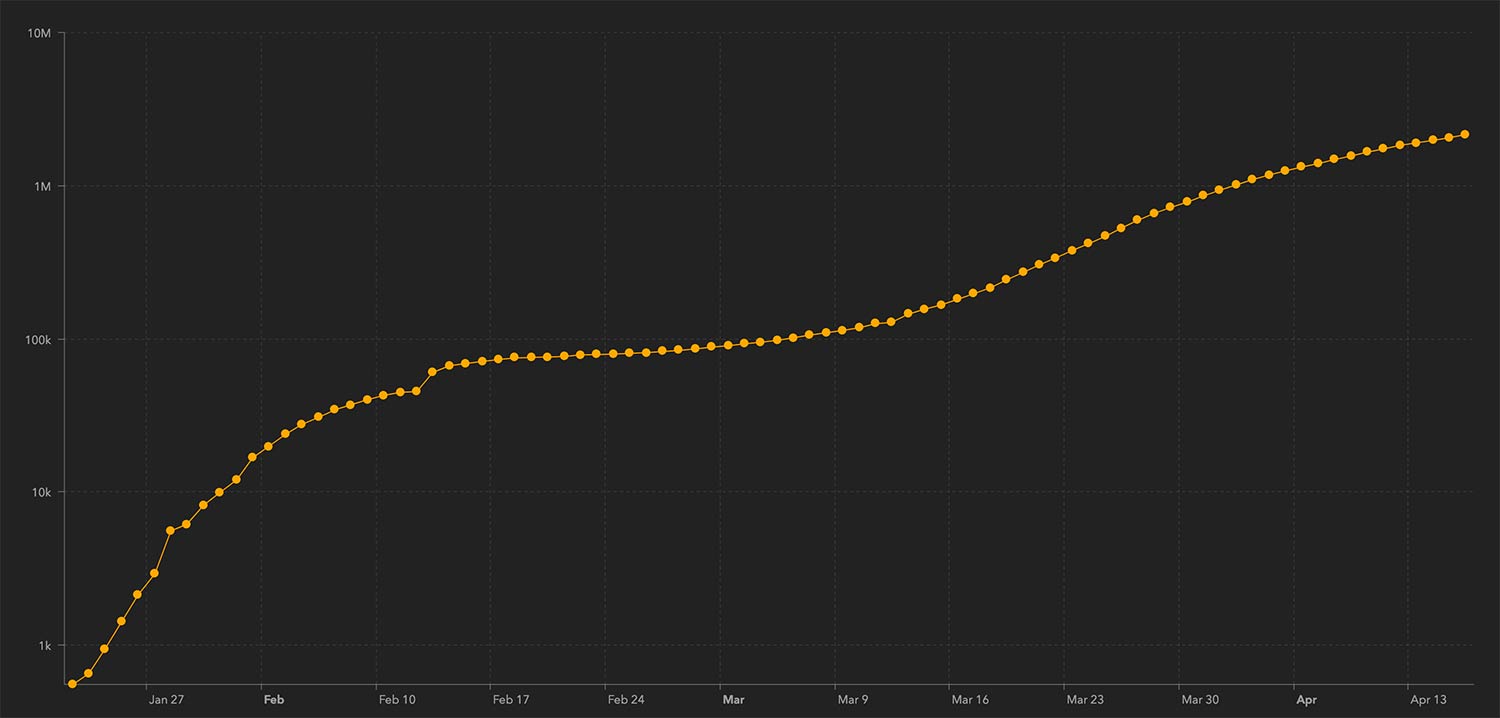
The chart shows the increase of confirmed COVID-19 cases in the world.
The graph shows that this is not over yet.
Image: Johns Hopkins University
The number of cases in the rest of the world has long exceeded those inside China.
Since Monday 16 March, there have been more COVID-19 cases worldwide than in China, the ground-zero of the outbreak.
A flattening of the curves could indicate that the rate of infections may have peaked, but the numbers in other countries are still rising. There was an unexpected peak between 12 and 13 February, a sharp rise of infections in China from 45,000 to almost 60,000 cases in just one day.
Early on Thursday, 13 February, Chinese officials announced that nearly 15,000 new cases and 242 more deaths were recorded in a single day in Hubei Province. The rise was explained by the circumstance that the authorities had expanded their diagnostic tools for counting new infections. [16]
What alarming is now, is the sharp rise of the disease in countries outside China. Within a few days, COVID-19 cases in Spain, Italy, and Iran have multiplied.

Cruise Ship Grand Princess off the coast of California.
Image: Damian Gadal
Cruise ships as breeding grounds for the virus?
There are several cruise ships affected by COVID-19 cases.
Grand Princess
The latest victim is the Grand Princess, a cruise ship which belongs to Princess Cruises, a subsidiary of Carnival Corporation & plc, the same company that operates the Diamond Princess.
The cruise liner with around 3,500 people on board is being held off the coast of California after a former passenger died from the virus. Passengers were asked to stay in their cabins while waiting for the coronavirus test. 21 people onboard have now tested positive for the coronavirus, including 19 crew members. It has been announced that the Grand Princess will be allowed to dock in the Port of Oakland, a major container ship facility, on Monday 9 March.
Diamond Princess
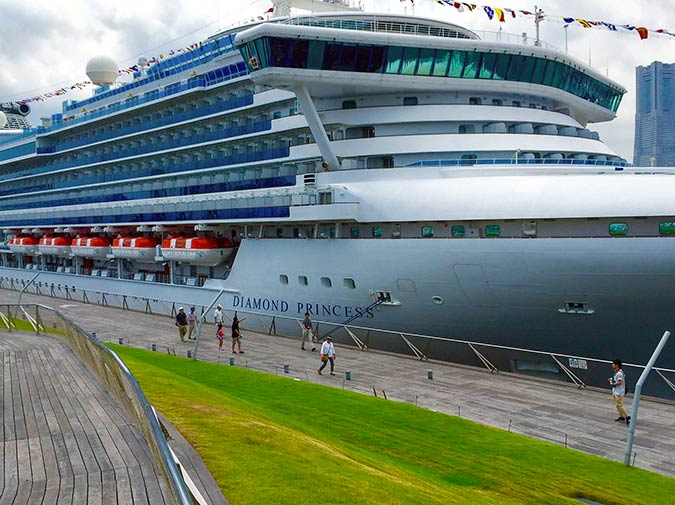
The Diamond Princess quarantined in Yokohama. There are several cruise ships affected by coronavirus cases.
Image: takewata69
On 5 February, the Japanese Ministry of Health quarantined the cruise ship Diamond Princess in Yokohama, a Japanese city south of Tokyo, after 64 passengers were diagnosed with the new virus. But more and more passengers fell ill since the beginning of the quarantine, in the end, about 700 people on board were infected.
The ship, owned by Carnival Corporation & plc, arrived at Yokohama from a 14-day round trip itinerary; it departed from Yokohama on 20 January and was scheduled to return on the 4th of February.
There were 2,666 guests and 1,045 crew on board. [2]
About 700 people tested on the ship contracted the coronavirus. Given the high number of cases, the question is why the Japanese authorities have not tested all people on board.
The quarantine ended on 19 February, and the Japanese authorities are faced with the task of testing thousands of passengers on board the ship. They will have to evacuate people who have tested positive for the virus or may have come into contact with someone and move them to medical facilities on land. [3]
About 500 people were able to leave the ship on Wednesday, 19 February. They tested negative for the COVID-19 virus and are now free to go wherever they want.
All remaining passengers and crew members of the cruise ship Diamond Princess, which has been quarantined in Yokohama port due to COVID-19 infections, disembarked on Sunday, 1 March, according to the Japanese Ministry of Health.
Anthem of the Seas
Miami-based Royal Caribbean, the owner of the Anthem of the Seas, has banned passengers and crew with Chinese passports from all of its cruise ships.
World Dream
The World Dream, a cruise ship operated by Dream Cruises, has been quarantined in Hong Kong after eight passengers became infected with the virus.
MS Westerdam
MS Westerdam, a Vista-class cruise ship, also managed by a unit of Carnival Corporation, was en route to the port of Laem Chabang, Thailand's largest port. The vessel was already turned away by four other countries, despite assurances from the shipping company that no one on board is infected with the coronavirus. But Thai authorities have also not allowed passengers to disembark in Laem Chabang. [4] Until now, Thailand has not imposed any restrictions on travelers from China or other countries.
Cambodia agreed to allow the cruise ship to dock at the Cambodian seaport of Sihanoukville on Thursday, 13 February. [5] [6] Sihanoukville has seen unprecedented levels of Chinese investment in the city, with numerous casinos have opened up throughout the city. [7]
AIDAvita
The German cruise ship in the South China Sea was refused permission to dock in Vietnam for fear of a coronavirus infection on board. AIDA Cruises is a subsidiary of the Miami-based Carnival Corporation. [8]
Note: Carnival Corp and Royal Caribbean Cruises are the world's biggest cruise companies, but they're also among the worst at limiting the pollution from their ships, according to the environmental-advocacy group Friends of the Earth.
Royal Caribbean Cruises Ltd and Carnival Corporation & PLC make up about three-quarters of global cruise activity, both based in Miami, Florida. Royal Caribbean Cruises Ltd emitted a total of 4,230 kilo-tonnes (1kilo-tonne = 1000 metric tons) of carbon dioxide equivalent in 2017. Carnival Corporation emitted a total of 10,690 kilo-tonnes (10 million 690 thousand tonnes) of carbon dioxide in 2017. [9]
More about COVID-19
2019–20 coronavirus pandemic by country and territory
Wikipedia coverage of the COVID-19 outbreak by country.
Advertisements:
Special Administrative Regions of China:
Other Countries in Eastern Asia:
Japan | Mongolia | North Korea | South Korea | Taiwan (ROC) | Vietnam
Major Cities in Eastern Asia:
Beijing, Busan, Chongqing, Guangzhou, Hanoi, Hong Kong, Kobe, Kyoto, Kunming, Lhasa, Macao, Nagoya, Osaka, Pyongyang, Saigon, Seoul, Shanghai, Shenzhen, Taipei, Tianjin, Tokyo, Ulaanbaatar, Yokohama
Unbelievable! Its comfort actually!
read moreAs time went by, this blog was developed for many different purposes. Last time, I had a lot of pleasure in sharing some of my Lego-related hobbies. However, I will mostly upload a blog about bikes and their development in the next few months! Recently, I have so much into ebike cargo. They say this type of bike can replace the car! And I am very into it since my place is crowded with traffic jams! The video above showed a funny situation: I started the review from Brooks's handle! And after nine years! It's still an excellent bike handle and not even destroyed!
read moreKeep Watching
Hi, hi, hi. So, it's been a while for the last couple of weeks since I have considered buying a cargo bike. The reason is that I am often trapped in a traffic jam because I can't get faster in my car.
read moreIndonesia has launched Southeast Asia’s first-ever bullet train, a high-speed rail line connecting two of its largest cities.Congrats! Indonesia launched Southeast Asia’s first bullet train.

Custom LEGO Transformers Devastator
My faith in humanity is restored! OK, that’s a bit overboard – but you couldn’t blame me if you see an incredibly, exquisitely and wonderfully executed custom LEGO Transformers Devastator such as this by Alex Jones. I feel transported to the 80’s once again, with the same intense childhood wonder when I first saw the Constructicons combine and become the formidable Devastator.

Collaboratively administrate empowered markets via plug-and-play networks. Dynamically procrastinate B2C users after installed base benefits. Dramatically visualize customer directed convergence without
Comments